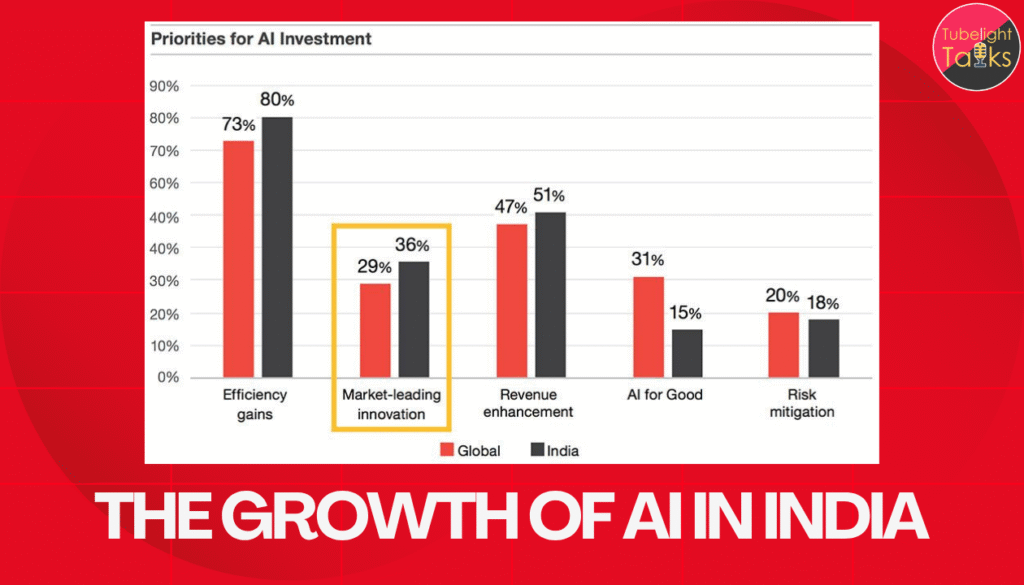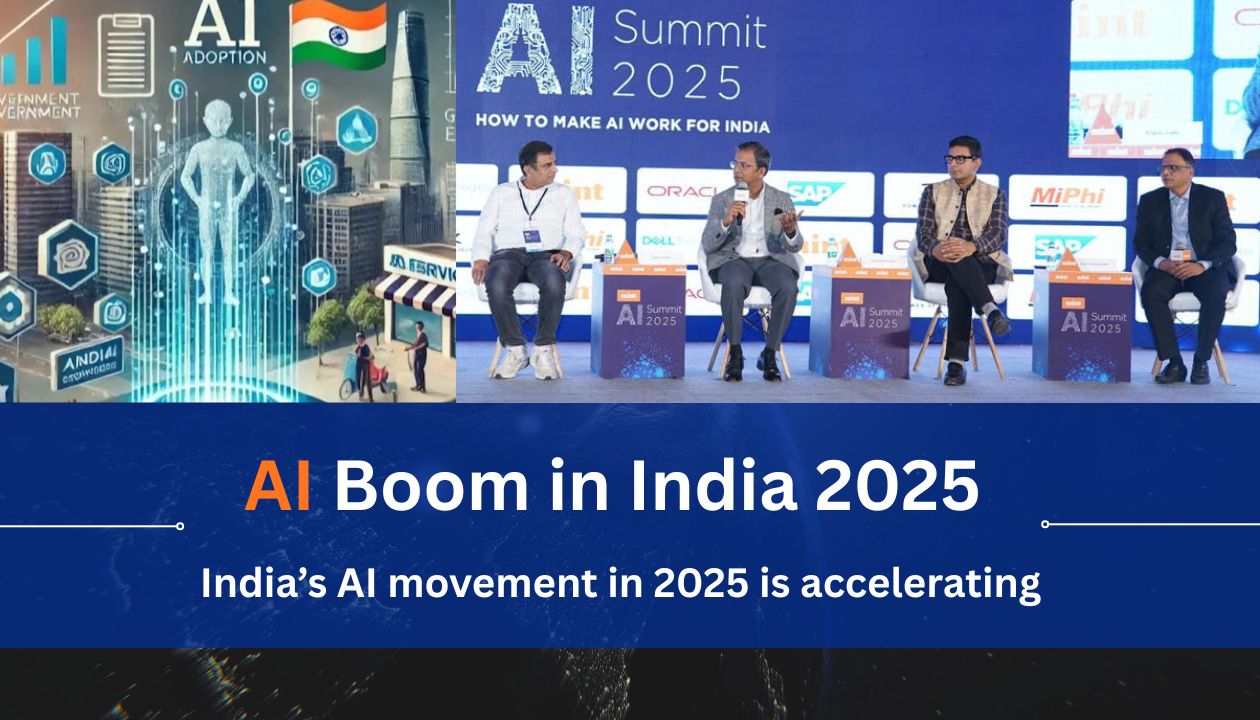AI Boom in India 2025 is accelerating across industry, government, and consumer devices. National reports and industry analyses indicate that, with broad adoption and supportive policy, AI could add hundreds of billions of dollars to India’s economy by 2035. The government-backed IndiaAI Mission has allocated a major funding package to build computers and infrastructure for AI. This article walks through verified trends in smartphones, jobs, everyday uses of AI, ethical challenges, and a spiritual perspective on balancing technology with inner well-being.
The Growth of AI in India

Government and Policy Initiatives
India’s government is laying a strong foundation for AI adoption through initiatives like the ₹10,300 crore IndiaAI Mission. Programs such as Digital India FutureLabs and AI Centers of Excellence, in collaboration with academic and industrial institutions, aim to foster indigenous AI models tailored to India’s diverse datasets. These efforts target critical sectors like agriculture, healthcare, education, and financial inclusion.
State-Level AI Adoption
State governments are also driving AI growth. For example, Telangana’s T-AIM (Telangana AI Mission) and Tamil Nadu’s Safe and Ethical AI Policy demonstrate localized efforts to integrate AI frameworks. These policies focus on ethical AI use and building region-specific solutions, ensuring broader national impact.
Private Sector and Startup Ecosystem
The private sector is fueling innovation, with AI startups in cities like Bengaluru, Pune, and Gurugram attracting significant venture capital. Healthtech, edtech, and generative AI ventures are seeing a funding surge, positioning India as a global hub for AI innovation.
Challenges for Inclusive Growth
Analysts emphasize that the success of India’s AI ecosystem hinges on inclusive access to data and compute resources. Robust regulation, citizen participation, and equitable resource distribution are critical to ensuring AI benefits all segments of society.
AI-Powered Smartphones: Redefining the Experience
On-Device AI Innovations
By mid-2025, premium and mid-range smartphones in India feature on-device generative AI chips. These enable real-time translation, advanced photo editing, and adaptive user interfaces that learn individual preferences, making devices more intuitive and personalized.
Multilingual Capabilities
Local brands are embedding AI voice models trained on Indic datasets, supporting seamless multilingual experiences across India’s diverse linguistic landscape. This allows smartphones to understand regional languages and accents, enhancing accessibility.
Telecom and Connectivity Enhancements
Telecom operators are leveraging AI to optimize network performance, reduce call drops, and deliver personalized content recommendations. These advancements are positioning India as one of the fastest-growing markets for AI-integrated devices globally.
AI Jobs and Career Opportunities

Emerging AI Roles
The AI wave is transforming India’s job market. While automation may displace repetitive roles, it is also creating new opportunities in fields like prompt engineering, data labeling, AI ethics oversight, and robotics maintenance.
Also Read: Google’s $15 Billion: Bet on India’s AI Future
Projected Job Growth
Reports from NASSCOM and the Ministry of Skill Development project a 20–25% annual growth in AI-related roles through 2030, provided reskilling programs are scaled effectively. This growth underscores the need for proactive workforce development.
Private Sector Skilling Initiatives
Companies like TCS (AI Ignite), Infosys (Topaz), and Google India are leading skilling efforts, training thousands in machine learning and data science. These programs aim to bridge the skills gap and prepare workers for AI-driven roles.
Rural and Semi-Urban Inclusion
Government-backed Digital Skill Hubs are expanding access to AI education in rural and semi-urban areas through online learning modules in local languages. This ensures that AI opportunities reach beyond metro cities, fostering inclusive growth.
AI in Daily Life: Practical Benefits and Real Limits
Everyday AI Applications
AI is transforming daily routines with tools like virtual assistants for reminders, smart health trackers for monitoring stress and sleep, and AI-driven crop monitoring for farmers. In education, adaptive learning apps personalize lessons, while e-commerce and fintech leverage AI for logistics and fraud detection.
Barriers to Adoption
Despite its benefits, AI’s reach is limited by unequal digital access, data bias, and high infrastructure costs, particularly in rural areas. Addressing these challenges requires improved broadband connectivity, better data quality, and increased user awareness.
Scaling AI for Broader Impact
For AI to truly revolutionize daily life, investments in infrastructure and education are essential. Ensuring equitable access will determine whether AI can deliver inclusive benefits across India’s diverse population.
Ethical Challenges and the Road Ahead
Data Privacy and Transparency
As AI adoption grows, concerns about data privacy and algorithmic transparency are rising. The upcoming Digital India Act is expected to provide a framework for data protection and accountability in automated decision-making.
Addressing Bias in AI
India’s diverse society offers a chance to build inclusive, multilingual AI models that reduce global dataset biases. Developing culturally aware AI is critical to ensuring equitable outcomes in sectors like healthcare and finance.
Balancing Innovation and Ethics
The next decade will test India’s ability to pair technological innovation with ethical responsibility. Robust guidelines and trustworthy datasets are essential to ensure AI serves the collective good.
A Spiritual Perspective: Using AI & Technology Mindfully
Sant Rampal Ji Maharaj emphasizes inner peace and spiritual devotion as sources of lasting happiness. He advocates using AI to enhance human well-being — improving health, education, and livelihoods — while adhering to ethical standards.
His teachings caution against excessive attachment to technology, urging users to maintain balance and focus on spiritual goals. True progress lies in uplifting humanity without losing sight of the pursuit of Supreme God Kabir’s wisdom.
FAQs
Q1. Is the India AI Mission real and funded?
Yes — the Union Cabinet approved an IndiaAI Mission with an allocation of around ₹10,300 crore to expand, compute and support AI innovation.
Q2. How big is AI’s potential economic impact for India?
National analyses estimate that accelerated adoption of AI could add roughly $500–600 billion to India’s GDP by 2035, though real outcomes depend on policy, investment, and skills.
Q3. Will AI create jobs in India?
Government roadmaps indicate that, with the right policies and skilling, AI could create millions of new roles in technology and customer-experience sectors in the coming years; however, transitions require active reskilling programs.
Q4. Are GenAI features widespread on smartphones already?
GenAI features have spread quickly across new models in 2025 — industry trackers report notable year-on-year increases in GenAI-enabled handset share — but adoption varies by price segment and region.
Q5. How should India manage AI risks?
With regulatory guardrails, data-privacy protections, ethics standards, investments in trustworthy datasets, and large-scale skilling initiatives so workers can transition into new AI-related roles.










